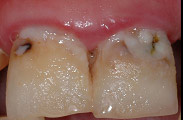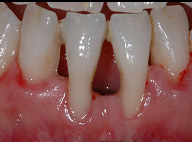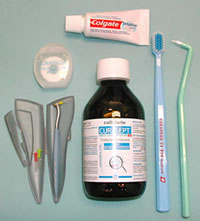Decay and periodontal disease are the two main pathologies affecting the oral cavity.
The former affects hard dental tissues, while the latter affects tissues supporting teeth (i.e. the bone and gingiva), causing tooth mobility and, in the end, tooth loss.
Bacterial plaque is mainly responsible for these diseases. It forms when bacteria in the mouth come in contact with food residues (materia alba).
They proliferate and form the bacterial plaque, which adheres to the teeth and gingival tissues (fig. 1).

Fig.1: Plaque and materia alba.
If plaque is not promptly removed, within a few hours bacteria activate plaque sugar fermentation and cause an increase in the acidity, which starts damaging the enamel of teeth. This triggers a mechanism which leads to decay formation. If it remains in the oral cavity, plaque mineralises due to the calcification of salivary proteins and forms calculus (fig. 2).

Fig. 2: Supragingival calculus.
The presence of plaque and calculus in the oral cavity causes an inflammatory response which is at first superficial and reversible (gingivitis, fig. 3) and, unless it is blocked, then invades deeper tissues causing periodontal pockets and alterations which are often irreversible (fig. 4).

Fig. 3: Gingivitis. There are different types of gingivitis.
The picture shows two clinical cases: on the left, chronic gingivitis affecting the entire upper arch; on the right, acute gingivitis associated with significant accumulations of plaque and calculus, oedema , redness and pain.

Fig. 4: Consequences of periodontal disease.
The inflammation caused the loss of bone and gingival tissue. Unless promptly treated, periodontitis causes the mobility of teeth and in the end their loss. Prevention treatments, which following the law and common sense should only be performed by graduate hygienists and/or physicians or dentists, aim at avoiding that this process continues undisturbed.
The hygienist is called to inform patients of these problems, to motivate them and instruct them about the way to maintain a good oral hygiene at home (fig. 5), to see the patients at regular intervals and to professionally perform hygiene treatments using sonic and ultrasonic hand-held instruments.
Specific genetic and salivary tests allow to assess individual susceptibility to periodontal diseases and decay. Patients who follow a good prevention programme and actively cooperate suffer from decay and periodontal disease much less than others.
When decay is already present or when the periodontal disease has already developed, the dentist will have to treat these problems.

Fig. 5: Instruments for oral hygiene maintenance at home.
